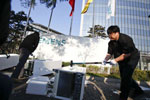Harmful omission
Updated: 2011-11-09 08:03
(China Daily)
|
|||||||||||
Suffocating smog has been covering Beijing like a greasy quilt recently.
Air monitoring data from the US embassy in Beijing started circulating on micro blogs last week suggesting the density of PM2.5, fine particles with a diameter shorter than 2.5 microns, was about 250 to 350 on Oct 30 and the general air pollution index was 425, reaching the level of "poisonous".
However, the index released by the municipal environmental authority that day was only 132 and the air was categorized as "lightly polluted".
The authority tried to comfort the public afterwards with the even more dubious assertion that the air quality in Beijing has continuously improved since 2008 when the city hosted Olympics.
As this contradicts residents' own experience they were - not surprisingly - quick to pour scorn on this notion.
But Wang Yuesi, a researcher with the Institute of Atmospheric Physics of Chinese Academy of Sciences, shed some light on the environmental authority's claim on Monday, when he said its conclusion is based on the monitoring of PM10, particles in the air with a diameter longer than 10 microns, which are less than they were before the Games.
However, in smog PM2.5 comprise the majority of inhalable particles. Wang's data indicates the density of PM2.5 on Oct 30 in Beijing was 145 mircograms per cubic meter, accounting for 61 percent of all inhalable particles that day.
Finer particles sink deeper into our respiratory systems and so do more harm to our health.
It is unrealistic for Chinese environmental authorities not to make PM2.5 a criteria for air quality, when it has long been the main cause of air pollution in many cities.
PM10 are caused by dust from soil and construction sites, while PM2.5 are produced by automobile exhausts and the burning of fossil fuels.
The number of cars in Beijing has rocketed from 1 million to more than 4 million since 1997. If PM2.5 is not monitored at all, it is very easy for the environmental authority to boldly conclude that the air is becoming better.
Although monitoring PM2.5 will expose how serious the air pollution is in Beijing, it will bring people's heads out of the sand and prompt people to do something about it.
All residents in the city are aware of the poor air quality, so it does not make sense to conceal it for fear of criticism.
Hopefully, the environmental authority will start to include PM2.5 in their monitoring, which will enable constructive and pragmatic interaction between decision-makers and society.
In the meantime one crucial task for the environmental authority is to warn the public of smog so they can take precautions.
Residents should also be encouraged to use their cars less and to conserve energy.
(China Daily 11/09/2011 page8)




